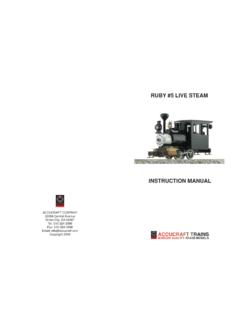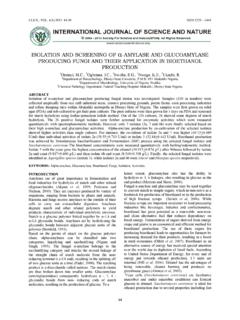Transcription of maxitrak - ACCUCRAFT TRAINS
1 Copyright 2013 maxitrak ltd Copyright 2013 maxitrak ltd Allchin Driving and Maintenance. Some tips on driving and looking after your maxitrak / ACCUCRAFT Allchin traction engine. Running in and fist time operation Once you have taken your model from the packaging it will need a mechanical check over to make sure it is in good working condition. Some models can get a rough ride on their way to you so bolts can come loose! Within the box you will find: 1 x traction engine mounted on wooden base. Tool set including: 1 x large syringe (boiler water filler) 1 x small syringe (lubricator filler) 2 x Syringe extension pipes (clear silicone) Large & small L shaped nut runner spanners Large & small Allen keys Spare nuts & bolts Spare water gauge glass Spare water gauge fibre washer Boiler & gas tank test certificates Give your model a good look over and tighten all loose bolts, pay particular attention to the front Perch Bracket holding the axel to the smoke box, there are 6 bolts that can come loose.
2 Using the Allen keys provided pay attention to the flywheel, rear wheels & gearing to make sure nothing has come loose, once you are satisfied all parts are tight it is a good idea to turn over the motion freely by turning the flywheel, to roll the model back and forth freely (when not in gear), check steering worm & gear and that the steering chain is in place, if your chain is to loose simply move it up a few links on the steering rods. Your model should now be ready for its first steam up! To steam you need, water, propane/butane gas, steam oil, lighter, cloths or tissues. Water your engine will run on almost any fresh water, however soft water will keep the boiler free from scale. Filtered rain water or water from a tumble dryer or dehumidifier are ideal. Gas The best gas to use is propane/butane mix though the engine will run on just butane. Gas lighter refills can be used direct but the cans sold for hand held blowlamps or camping stoves are more economical.
3 For these you will need an adaptor that screws on to the top of the can to match up to the filler valve on the engine (available from maxitrak ). Copyright 2013 maxitrak ltd Oil Use only steam oil in the lubricator, do not use gear oil as the additives in these oils will come out in the steam and attack the seals etc. Ordinary car oil can be used on the crank, valve gear, axles and wheels but as the whole engine gets hot it is a good idea to use steam oil for everything. Lighting A lighter of the type used for gas cookers is a very good idea and will save burnt fingers! Matches can be used with care but are a poor substitute when it comes to relighting a hot burner . Diagram Study the diagram on the back pages so you are familiar with the controls and working parts of the engine before firing up.
4 Use cloths or kitchen tissues for wiping down spilt oil or water and for a final clean up after a run. Starting the run Remove the Knurled boiler safety valve and fill the boiler with water. Watch the level of water in the water gauge, it needs to be about three quarters up the glass. Replace the safety valve when correct. Make sure the gas valve is closed before filling the gas tank. Do this in a well-ventilated area well away from any flame. NO SMOKING. If using the larger gas canisters start by screwing on the adaptor, then invert the canister and press the end of the adaptor on the gas filler valve. Liquid gas is transferred from the canister to the locos own gas tank, as this happens gas is vented from the tank to make room for the liquid. Venting gas is quite normal, make sure there is no flame near by. After thirty seconds or so the tank will be full, stop when liquid starts to vent with the gas.
5 Stop if any ice or frosting appears round the filler valve. Several short bursts of filling may be better than one long one. When the tank is full and the gas dispersed the burner may be lit. Light the burner by removing the smoke box door and turning on the gas valve. You will hear the gas hissing out of the burner . Put the lighter in the smoke box and light the gas, it will pop back down the boiler tubes to the burner . Check that the burner is alight and replace the smoke box door. Note: The noise of the burner is quite different between when the gas is on and when the burner is alight, if you get used to listening to the difference you will know if all is well ( burner on) or if you are about to run out of steam ( burner out). A change in the burner noise may mean a quick look in the smoke box is required to check the burner is performing correctly. Copyright 2013 maxitrak ltd There is an air intake adjustment on the burner , move this to cut the air intake if the burners tend to cut out on full gas.
6 The burner is most temperamental when cold so may need further adjustment once you have the engine running. Once you are confident with the operation of the burner you can light the gas under the front axle perch bracket or through the smoke box door. It takes about five minutes to get steam up so oil round all the moving parts while steam is raised. This should include all the following items, valve gear, crosshead, crankshaft bearings, connecting rod, gears, back axle bearings, front wheel bearings. Unscrew the filler cap from the lubricator. If the loco has been run before you will need to drain water from the lubricator this is done with the small syringe through the filler hole. Fill the lubricator with steam oil, re-fit the filler cap when the lubricator is full. There is no adjustment on this lubricator it is pre-set to give the right amount of oil for one run. Running the engine When the pressure gauge begins to register the engine can be run.
7 Start by putting the reversing lever in to full forward. Open the regulator gently and turn the flywheel. Once the condensation is cleared the engine will start to run, it may take a couple of turns by hand to clear water from the cylinder. Control the steam with the regulator to give a steady speed. It is not necessary to stop before putting the engine in reverse though it might need a turn on the flywheel to get it running in the opposite direction. If the engine is running light the burner can be turned down to give a longer run. If the burner is left on full, pressure will continue to increase. When a little more pressure has built up the engine can be put in gear and driven. Close the regulator to stop the engine. Copyright 2013 maxitrak ltd Take out the locking pin and move the gear lever to engage the gears, (turn the flywheel slightly if the gears do not line up).
8 Replace the pin, open the regulator gently. Spin the flywheel and the engine will drive. Set the steering so the engine drives in a circle, avoid hitting any obstacles! NOTE: If the engine is started at high pressure or run at high speed the burner will show a tendency to blow out. When pulling heavy loads you are working the engine hard and it might be difficult to avoid this situation. It is down to the drivers technique, burner air adjustment and keeping a good ear out for the state of the burner . If you try pulling full size passengers it is most important that riding cars have ball race bearings and are of a light construction. You are asking the little engine to do a well over scale job. Only do this on solid level ground. You will need 5 to 20 PSI to run the engine 20 to 40 to drive with light load 40 to 60 to do passenger hauling Keep an eye on the water level in the boiler, while running the water level will slowly go down when the level becomes low in the gauge glass the run must be stopped.
9 Turn off the burner and allow the steam pressure to drop. To repeat the run wait for the boiler to lose all pressure, remove the Knurled water filler carefully and re fill with water. Top up the gas tank, drain and refill the lubricator, light the burner and start again. If the engine is warm working pressure will be achieved quicker than starting from cold. After the run Oil, water and gas can be left in the engine after the run but the boiler should be drained for long-term storage, Avoid water freezing in the boiler as this will permanently damage it. Wipe down all oily or dirty parts and polish the brass as desired. The engine will soon assume the patina of use so typical of a working steam engine though some owners like to keep their engines in as new condition. Copyright 2013 maxitrak ltd Long-term maintenance Use tap water in a new boiler to build a thin layer of fur which will help settle the boiler.
10 To prevent further build up use rainwater or distilled water, or de fur the boiler occasionally using ordinary kettle or steam iron de-scaler. Do not allow the boiler to run dry or it may be damaged. A hydraulic test to 120 lbs pressure should be done every four years, you will need special equipment to do this or join a club who will do this for you. This can be done through maxitrak or the maxitrak Owners Club (for members only). After considerable use the motion will show signs of wear. The big end can be tightened by removing the cap and rubbing on emery clothe to tighten the bearing. All other parts will need to be replaced. Health and Safety Please be aware this is a working live steam model, many safety issues are the same as on a full size engine. HEAT, all parts of the boiler, cylinder and smoke box are very hot and should not be touched. MOVING PARTS, the cylinder, valve gear and drive gears should not be touched when moving.











